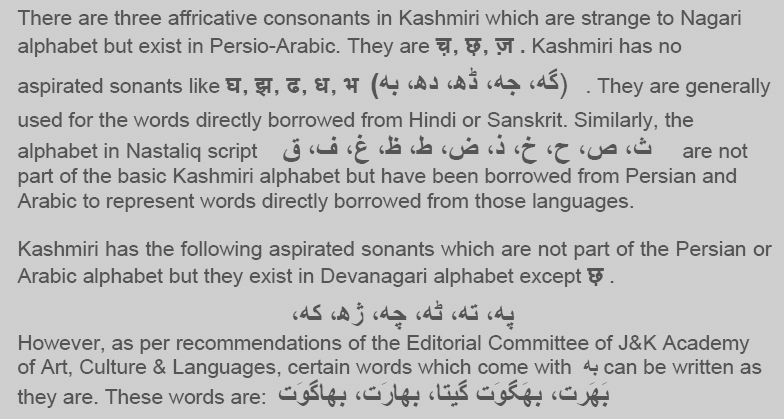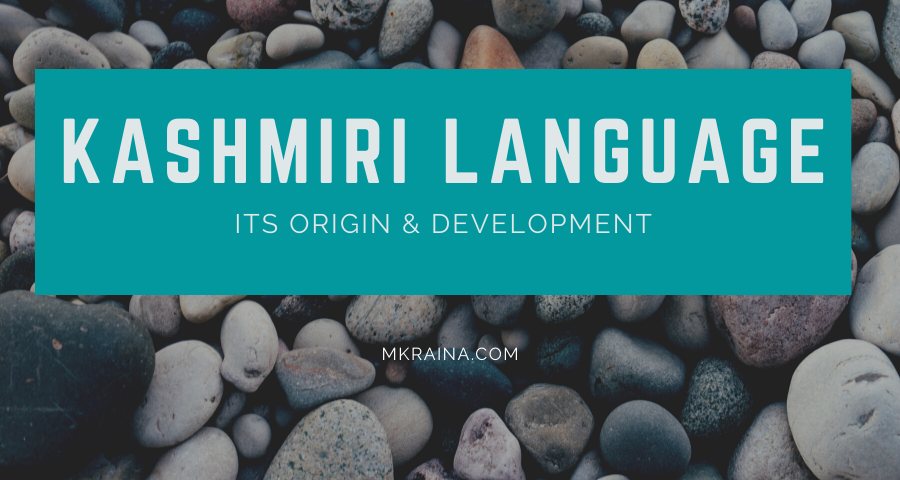Kashmiri language is the language of the valley of Kashmir. In a dialectic form, it has spread South-west into the valley of Kishtwar and to the South, it has flowed over the Pir Pantsal range into the lower hills lying north of river Chinab where it appears in a number of mixed dialects. People of Kashmir call this language Koshur. As per the census figures of 1981, there were about 31 Lac native speakers of the language in Kashmir. However, the J&K Academy of Art, Culture and Languages puts the total number of people understanding or speaking Kashmiri worldwide at about 100 Lacs.
There is no consensus of opinion regarding the origin or geneological classification of Kashmiri. There are basically two schools of thought. One places Kashmiri under the Dardic group of languages and the other places it under the Indo-Aryan group of languages.
There are many views about the origin of Kashmiri language. Kashmir Census Report for 1911 says “Kashmiri used to be hitherto treated as of Sanskrit origin. It has this time been grouped with Shina-Kohwari according to revised system of classification but the claim locally urged that it is essentially a Sanskritic language and in view of the historical fact that the valley of Kashmir before its conversion to Islam was wholly populated by Brahmanas with Shastaric lore, that claim may merit consideration.” In his write up on Kashmiri Language, N.L.Chatta says, “The inhabitants of this land are no doubt representatives of an early immigration from India proper, so it can be said that Kashmiri language has a Paschachi base. Paschachi group of languages is now known as Dard group of languages.”
Sir George Grierson is the first Europeon Scholar who has attributed Kashmiri language to the Dardic group. According to him, Kashmiri was developed in Dardistan, the mountainous region between the North West of Punjab and the Pamir. Leaving aside Arabic, Persian and Sanskrit words from the language, remaining words are Dardic or Paschachi. Kafiri (spoken in the west of Chitral), Shina (spoken in Gilgit), Kashmiri, Kishtwari and Kohistani belong to this group. Grierson adds that Kashmiri has immensely and for centuries been influenced by Sanskrit. Some scholars believe that while discussing the origin of Kashmiri language, Grierson has neglected two aspects of Sanskrit which are responsible for making the fundamental base of this language. These aspects are Tatsam and Tadbhava words. Prakrit and Apbhramsha have also been totally ignored by him. Without these basic ingredients, the structure of Kashmiri language can not be said to have strong foundation.
Grierson adds that “Kashmiri has immensely and for centuries been influenced by Sanskrit.”
The Dardic speeches fall into three branches: (1) Shina including Kashmiri, Shina proper and Kohistani, (2) Khowar or Chatrari or Chitrali and (3) Kafaristant or Nuriatani dialects in some Afghan territories.
Professor Ersnt Kuhn of Germany was the first research scholar to suggect that the dialects of Hindukush region along with Kashmiri formed a separate group within the body of Indo-Aryan languages. Many scholars claim that Kashmiri is Indo-Aryan rather than Dardic. Another view is that the language has its origin in Saryani and Abrani, the language of Jews who came to Kashmir about 2000 years back.
Kashmiri has borrowed, with adaptation, a large number of vocabulary items from Sanskrit, Persio-Arabic sources and most recently from English. These borrowings have resulted in various phonological changes and the development of certain morphological characteristics.
Kashmiri is written in three scripts viz Sharada, Persio-Arabic and Devanagari. Hindus, it is said, used Sharada to write Sanskrit in ancient times and later used this alphabet to write Kashmiri as well. They have now mostly switched over to Devanagari. Hindus also learned Persian language and used Persian alphabet to write Kashmiri after the advent of Afghans and produced great scholars. Muslims in general use Persio-Arabic called Nastaliq. This script with additional diacritical marks has been recognised as the official script for Kashmiri by the Jammu & Kashmir government and is being widely used. The Roman script has also been used for Kashmiri but could not become popular. Kashmiri Pandits for quite some time now have been pleading with the goverment to recognise Devanagari-Kashmiri as an additional script for the Kashmiri language, which is yet to bear fruit.
Kashmiri is written in three scripts viz Sharada, Persio-Arabic and Devanagari. Hindus.
During Hindu rule, Sanskrit was the official language of Kashmir and it continued so till the times of Sultan Shahab-Ud-Din. During these times, Sanskrrit was written not in Devanagari but Sharada script, from Kashmir to Kabul. Almost all the ancient Sanskrit literature of Kashmir is written in this script which include Mahanay Prakash and Lalla Vaakhs compiled by Bhaskar Razdan.
Sharada script was much in use not only in Kashmir but also in North Western India (Gilgit etc), Punjab and Himachal Pradesh and even in Central Asia. This script enjoys a foremost position among all the ancient Indian scripts. It was evolved from the Western branch of Brahmi nearly 1200 years ago. An alphabet, par excellence, the Sharada has remained for several centuries a popular script of an extensive area of North West India including Gandhara or North Western part of Pakistan, Ladakh, Jammu, Himachal Pradesh, Punjab and Delhi. This much is certain that it must have originated in Kashmir which from the earliest times has been the principal seat of Sharada, the Goddess of learning. When did Nagari alphabet replace Sharada alphabet, is not conclusively known. Mr. Jia Lal Kaul, a member of the Scripts Committee constituted by J&K Govt. in 1953 recommended Nagari script for Kashmiri language. His suggestion was seconded by Nadim and Amin Kamil but was rejected by majority of other members.
The earliest Sharada inscription on a stone slab dating back to 774 AD was discovered at the village Hund at Attock in Pakistan.
The earliest Sharada inscription on a stone slab dating back to 774 AD was discovered at the village Hund at Attock in Pakistan. According to Pandit Anand Koul Bamzai, Sharada alphabet were used in stone inscriptions even up to the 18th century. This is corroborated by his discovery of a Sharada inscription dated 1789 AD. Sharada script is said to have reached perfection by the middle of the 15th or 16th centuries. However, the epigraphists Kielhorn and Hoernle hold the view that Sharada alphabet is a very conservative alphabet as it changed very little across the centuries.
Walter Lawrence, who was in Kashmir from 1889 to 1895 in connection with the land settlement, has used Roman alphabet for many Kashmiri words in his book ‘The Valley of Kashmir’. Later George A. Grierson, the author of ‘A Dictionary of the Kashmiri Language’ worked hard to devise diacritical marks along with Roman alphabet to represent Kashmiri words. Other European authors and linguists also used Roman alphabet for writing Kashmiri but there was no similarity. Everybody used it differently. Pratap magazine also carried Kashmiri language in Roman script for a long time but later shifted to Urdu script.
In the standard Kashmiri of today, there are minor differences of language. For instance, Kashmiri spoken by Muslim slightly differs from that spoken by the Kashmiri Pandits. Not only is the vocabulary of the former more overlaid with the words borrowed from Persian, but also there is slight difference in pronunciation too. Similarly, there is difference of pronunciation between the talk of a villager and that of a townsman.
Kashmiri is what may rightly be called a vowel language. It has not only many vowels but its vowel system is intricate. It has semi-vowels and shades of vowel sounds.
There are some sounds peculiar to Kashmiri, not found in Hindi, Sanskrit, Persian or Arabic languages. Linguists and experts had to work hard to devise sets of diacritical marks to denote these vowel sounds in the Devanagari and Persio-Arabic scripts. For Devanagari, a team of linguists and experts headed by Dr. Roop K. Bhat spent years to discuss various options and finalised a set of 6 diacritical marks in the year 2002. Other experts who worked with Dr. Bhat were Dr. S.N.Bhat Haleem, Dr. S.S.Toshakhani, Dr. O.N.Kaul, Prof H.K.Kaul, Prof C.L.Sapru, Prof R.L.Shant, Dr. S.N.Raina and Dr. R.N.Bhat. This led to standardisation of the Devanagari-Kashmiri script and enabled production of Primer and Reader for the language in Devanagari. The script is however, yet to be recognised by the government.
As regards Nastaliq (Persio-Arabic) script, experts were working on it since 1959 when the J&K Academy took steps to prepare a Kashmiri Dictionary in this script. In a meeting of the two Editorial Boards of the Academy (one for Kashmiri dictionary and the other for Urdu-Kashmiri dictionary), the Script was finalised and guidelines issued for compilation of the Dictionary which also marked the standardisation of the Persio-Arabic script. Experts who contributed towards finalisation of the Nastaliq script and compilation of Kashmiri Dictionary in this script included Shri Akhtar Mohi-Ud-Din, Mirza Ghulam Hassan Beig Arif, Prof.J.L.Kaul, Prof. Mohi-Ud-Din Hajini, Prof. P.N.Pushp, Shri Abdul Khaliq Tak, Shri Bashir Akhtar, Shri Chaman Lal Chaman and Shri S.K.Toshakhani Chief Editor.

Kashmiri has been unnecessarily denied the right of an official language in its home state. It is also unfortunate that the children in the valley of Kashmir have been mercilessly denied their fundamental right (protected by the Constitution) of learning their mothertongue as a subject and through their mothertongue learning other school subjects. Kashmiri was introduced as a school subject at the primary level after independence and it continued to be taught upto the year 1953. It was suddenly scrapped from the school curriculam under the pretext of reducing the language load of the children. Some time back, a post-graduate department has been set up at the University of Kashmir. The Department offers instructions in a post-graduate diploma and M.A. in Kashmiri. The Board of Secondary Education, Kashmir has made a provision of its study as an optional subject in the two years of secondary education.
[Sources: ‘On Kashmiri Language’ and ‘Promoting Mothertongue’ by O.N.Kaul : Kashmiri Pandits & Cultural Heritage;
Kashmiri Zaban Aur Shairi Part 1 : J&K Academy of Art, Culture & Languages, Author Abdul Ahad Azad;
Kaashir Dictionary – Part 1 : J&K Academy of Art, Culture & Languages;
Lalla Rookh Rediscovered : Essays by N.L.Chatta & K.L.Kalla
Kaashir Zabaan Ta Adab : J&K Academy of Art, Culture & Languages Edited by Mohd. Amin Kamil;
Glimpses of Kashmiri Culture – Series 4 : ‘Vedic & Kashmiri Language’ by B.N.Shastri]
Learn Kashmiri Language – Series by M.K Raina
- One Page Primer on Kashmiri Language
- Basic Reader For Kashmiri Language
- Let Us Learn Kashmiri – How to Read and Write Kashmiri?
- Workbook for Kashmiri Language


